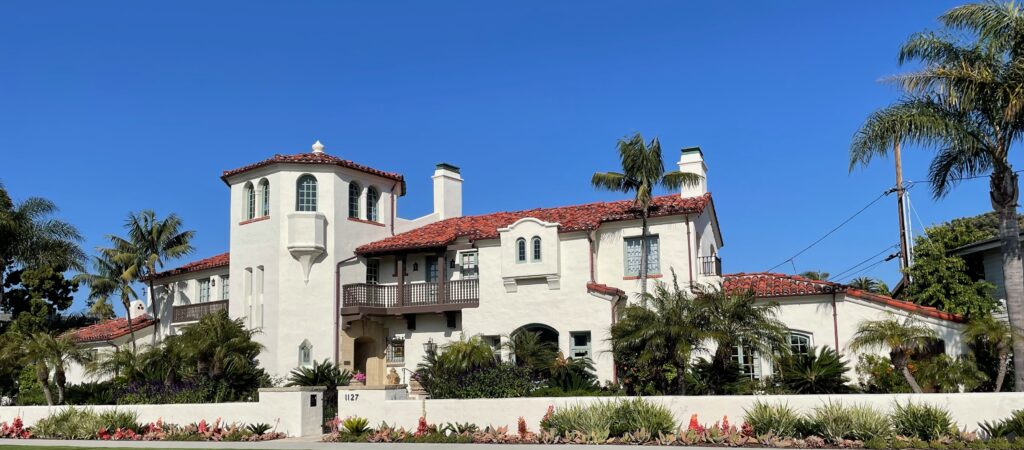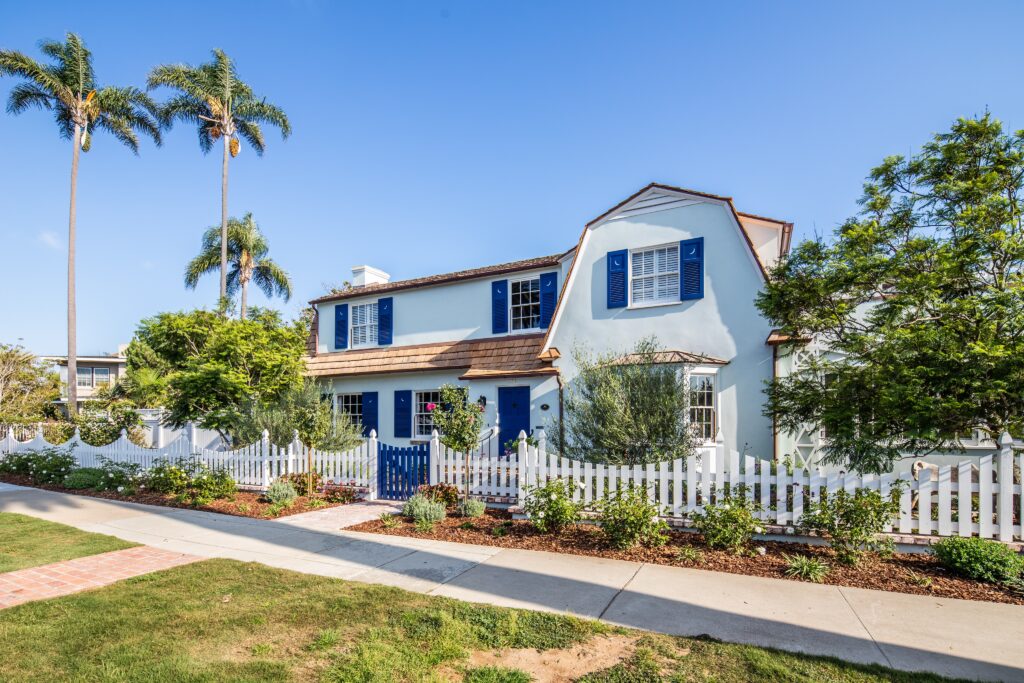 By Mary Farley, CHA Volunteer & GEM Committee Chair, and Jamie Jamison, CHA Board Member & GEM Committee Member
By Mary Farley, CHA Volunteer & GEM Committee Chair, and Jamie Jamison, CHA Board Member & GEM Committee Member
This article is the third in a series about CHA’s Going the Extra Mile Award.
Each year, the GEM Committee considers historic homes and properties that have been nominated by CHA membership. GEM Award finalists must have completed a recent restoration or renovation project true to the historic character of the home by December 31 of the prior year. The GEM committee researches the history of each home before making its selections. The Coronado Historical Association’s GEM Committee is pleased to announce this year’s finalists in a series of articles over the next few weeks. The winner will be honored at the Annual National Preservation Month Symposium on Thursday, May 21, 2021. These are Coronado’s GEMs. These owners truly Go the Extra Mile.
1127 F Avenue

In 1925, Coronado saw the collaboration of renowned Architects Richard Requa and Herbert Jackson, along with Builders A.E. Keyes and the Reed Brothers culminate into our next beautiful GEM nominee, 1127 F Avenue. This Mission Revival ‘castle-like residence,’ was originally built for Michigan furniture manufacturer, W.A. Gunn. It was designated a Historic Resource in 2004 and received its Mills Act recognition on October 30, 2016. It served as an illustration for Requa’s 1926 article in San Diego Business titled The Architectural Style for Southern California.
The original cost of the home was $56,558 which was well over ten times the average cost of a typical Coronado home at that time. Notable residents include Albert H. Lahman (1952), Sherman Hartland (1961), and Eugene H. Ephron (1969).
In her 1982 Master’s thesis, Mary Taschner wrote: “In 1924, Requa had begun another elaborate house for William A. Gunn of Coronado. Although not as large as the Del Mar Castle, the Gunn house has many of the same [castle-like] characteristics … The Gunn house has a long sprawling plan with an angled wing and varying roof levels [and] dominated by a huge tower or turret. Because the Gunn house is smaller, there is only one tower that serves as both the entrance hall and upstairs turret room. Perhaps because the Gunn house seemed more like a home than a castle, Requa lavished more attention on the garden than he had at the Del Mar Castle. He turned the pie-shaped Gunn lot into a formal Moorish garden complete with a tiled fountain, pergola, and lath house. As with the Harding house, Requa also included quarters for the servants at the far end of the garden.”
“When we started, I was optimistic, and I thought the work would take 2 years at most. It turned into a 4-year opus,” Brian Mariotti describes his odyssey to renovate 1127 F Avenue. Brian remembers his initial sense of an “old Hollywood, Spanish vibe” when walking into the home, but noted the rest of the house did not share what he and his wife Shannon loved about the façade and entry hall of this “Coronado Castle.” The floors upstairs were covered with wall-to-wall carpet with popcorn ceilings overhead. The incongruence isn’t surprising as the home had changed ownership many times since its 1925 birth. In fact, the home seemed to lose a bedroom and gain a bathroom over time, from 6 bedrooms and 5 baths to 5 bedrooms and 6 baths to 4 bedrooms and 7 baths from the ’70s to the late ’90s.
Brian and Shannon along with their team led by San Diego architect Kim Grant and Papenhausen Construction set out to restore what they could replace with old materials or replicated elements. Brian gratefully added that Grant, who specializes in historic homes, and Papenhausen “were particularly good at presenting us with all our options, but my wife and I always defaulted to the most historically accurate option. We love the old, lived-in feel.”
All the windows were scraped, and hand-painted. The popcorn ceilings upstairs opened and pitched. Ceiling beams of over 100-year-old wood were added, many with hand-painted detailing. Hundred-year-old terracotta flooring was found for the main level and Moorish tiling from Mexico for the staircase risers. Additions to the nascent Moorish influences are sprinkled everywhere. Moorish stars and designs can be found inlaid on the floors, walls, and ceiling.
On the main level, a family room was added to the west wing of the house, meticulously mirroring the style of Requa’s façade. The dining room was pushed out to capture what had been an outside space, and custom glass doors outline the space in between the stone columns along the rear wall facing the backyard. The backyard space presents another living space featuring a large living and dining room pavilion. A putting green, dog run, and pool with a diving board complete the fun zone. Carefully preserved 100-year-old olive trees mesh beautifully with newly added 250-year-old stonework around the pool and Moorish ironwork features of the facades of the converted original garage to the guest house as well as the new garage.

532 Marina Avenue
Kathleen Stengel, who grew up taking the ferry over to Coronado’s Strand Beach, always remembered the peace, wide-open space, and connection to nature with fondness. After settling her mother’s estate and realizing they no longer had a home base in San Diego, Kathleen began a search for one. Always attracted to historic homes, especially ones in need of love, the Stengel’s settled on a historic cottage at 910 F Avenue.
Having admired Lorton Mitchell’s work in Coronado, the Stengels engaged him as the builder and Dorothy Howard as the architect to design and rebuild the back house at 910 F Avenue in the style of the historic front cottage. Kathleen and Jim were still based in Cincinnati, coming to Coronado for sun infusions as much as possible while beginning to consider retirement and a forever home. Julie Goodwin, their realtor, showed them 532 Marina and Kathleen fell in love. However, the first offering did not work out. “Two years later Julie alerted me that Marina was in escrow and I was surprised how worried I was that the new owners wouldn’t take care of the home, worse yet tear it down, as it was not designated historic. I felt like I had to save this house”. As fate would have it, escrow fell through and Jim made an offer that was accepted unbeknownst to Kathleen. He wrapped up a photo of the house and gave it to his wife for Christmas.
This home is now a GEM Nominee. A Dutch Colonial Revival home, built-in 1929 by A.M. Southard, Builder, and Edgar V. Ullrich, Architect, the home was designated a Historic Resource in 2018 and received Mills Act recognition on December 24, 2019. The most recent renovation was done by TONTZ Construction with Kevin Rugee as Architect.
The home was originally built for Charles F. De Long and his family. De Long was the nephew of Philadelphia millionaire Frank E. De Long, who invented the hook and eye fastener for clothing. Frank himself, later moved to Coronado after several visits with his family living at 532 Marina. The De Long family only resided at the property for a short five years, moving after the passing of Mrs. De Long in 1933. Another resident, a tenant, was Commander Robert H. Caldwell, Jr. Caldwell received the Navy Cross while he and his young family lived in the home. He was recognized “For extraordinary heroism in action as Commanding Officer of a submarine on war patrol.”
One of the most notable residents of the home was Nick Reynolds of The Kingston Trio, who lived there as a child. Captain Stewart S. Reynolds, USN, and Mrs. Reynolds settled their family into the house in 1933. The Navy family occupied what came to be known as “the Reynolds House” on-and-off for six decades. They were active in the community in a number of ways; everything from hosting high-ranking military officials to participating in local tennis tournaments. Nick spent several of his childhood years in the home and received his early musical education there.
“We chose Kevin Rugee and Mike Tontz, who had always been a big fan of Lorton Mitchell”, to help us bring Marina 532 back to life, Kathleen explained. They began with all the doors and windows removing all the glass to send up to LA to be dipped in acid to remove the old paint. Once restored the panes were put back in place. What had to be replaced was replaced with all period-appropriate detailing, including interior door fixtures and hardware. The original wood shingles were a darker brown cedar shingle in need of replacing, and eastern cedar which greys like driftwood versus the dark brown cedar was a perfect choice.
Amazingly the footprint of the home is the same as are the gorgeous wood floors and 680 original era-appropriate window panes. The home itself is joyful, such as the blue living room with red accent furniture, pillows, and curtains, many of which Kathleen herself sewed. The grounds deserve more than a mention as an extension of the interior of the home which itself feels like a colorful secret garden.
The Stengel’s have brought 532 Marina Avenue back to a new life that harkens to the Reynolds family era of the home and an approach to life as a celebration. An overall sense of open-armed welcoming as you walk through the home, the embodiment of the joy that living by the sea brings, is what the Stengel family has come home to after “Going the Extra Mile”.




